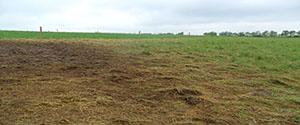Renovating High-Traffic Areas
 High-traffic areas, such as feeding areas, sacrifice lots, alleyways, gateways and waterers, are often bare and muddy late winter and early spring. To slow and reduce soil erosion, compaction, forage damage, and weed problems, these areas need to be renovated promptly. Reducing these muddy areas is beneficial for animal health.
High-traffic areas, such as feeding areas, sacrifice lots, alleyways, gateways and waterers, are often bare and muddy late winter and early spring. To slow and reduce soil erosion, compaction, forage damage, and weed problems, these areas need to be renovated promptly. Reducing these muddy areas is beneficial for animal health.
The ideal recommendation to renovate such areas is to fence it off to do a permanent seeding. This would allow a producer to use traditional forages such as fescue, orchardgrass, or Kentucky bluegrass. The problem many face is having to leave this area out of normal production for at least six months for these forages to establish well enough to graze. When a producer is not able to take the area out of production to renovate, both perennial and annual (Italian) ryegrass are good options for spring ground cover and where high traffic areas are damaged every winter. Perennial ryegrass is more susceptible to summer slump than other cool-season grasses. However, with proper management (fertilization and rotational grazing) they usually survive for 2 years in KY pastures and provide high quality pasture. Annual ryegrass is a temporary fix, and usually dies out during KY summers. If using annual ryegrass for a spring cover seeding, ask for Italian type varieties.
These cool-season forages work well to renovate high traffic areas because they establish easier and more quickly than other common perennial forage species. They are frequently used as cover crops for row crop production. The dense, shallow root system not only reduces erosion but also improves soil aggregate stability, reduces current compaction by breaking up dense soils, and helps to prevent future compaction. Vigorous growth helps these forages to outcompete unwanted late summer and winter annuals.
Annual ryegrass is more vigorous than perennial ryegrass, but provides only short term grass cover. It will die out during the summer whether it is planted in the spring or the fall of the previous year. The advantage of late summer or fall planting is high quality late fall and early spring grazing. Some producers mix annual and perennial ryegrass to obtain quick cover from the annual ryegrass and longer term survival from the perennial ryegrass. Spring seeding annual ryegrass is a temporary fix that usually only lasts 3-4 months. Seeding annual ryegrass in the early spring can be achieved by the same seeding methods as perennial ryegrass.
Establishment of perennial ryegrass is similar to that of other cool-season grasses. Drilling seed into a firm seed-bed is recommended for best seedling establishment. Perennial ryegrass can be seeded in the late summer/fall (Aug. 20-Oct. 1) or early spring (Feb. 1-April 15). Frost seeding ryegrass by scattering seed on the soil surface is a possibility in February but it is suggested that seed be drilled into the soil for maximum success. Fertilizer and lime should be applied according to soil test results. Split applications of nitrogen (40-60 lbs/acre) is beneficial for maximum pasture production. Using high quality seed of a variety suited for the intended use is important. Using a winter hardy variety is suggested as this species is not highly tolerant of extremely cold temperatures. Reduce competition from weeds and other unwanted species. If possible, keep livestock or heavy traffic off newly seeded areas for a month to allow for seedling establishment. Rotationally graze for maximum efficiency. Do not overgraze and allow for an adequate rest and regrowth period.
In conclusion, annual and perennial ryegrass both offer a short term fix to high traffic areas, but perennial ryegrass has the advantage of surviving two seasons. For long term productive pasture stands, seed improved varieties of tall fescue, orchardgrass and Kentucky bluegrass.
The table below contains the suggested management of ryegrass in Kentucky. See the 2014 ryegrass variety trial report for more information regarding varieties to plant.
| Species | Seeding Depth | Seeding Rate | Height to Start Grazing | Height to Stop Grazing |
| Annual (Italian) Ryegrass | 1/4 - 1/2" | 20-30 lbs/acre | 8-10" | 2-3" |
| Perennial Ryegrass | 1/4 - 1/2" | 12-25 lbs/acre | 6-8" | 3" |
Categories:
General
Establishment/Renovation


